PENNSYLVANIA THROUGH THE EYES OF

WOMEN IN ART
The Struggle For Equality

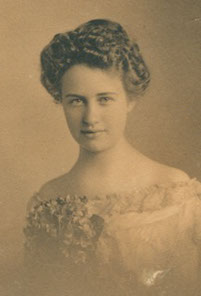
Fern Coppedge: With Philadelphia Ten (top left figure), Early photo of Fern



Art pioneers Mary Cassatt, Georgia O’Keefe and Frida Kahlo
“The men liked to put me down as the best woman painter.
I think I’m one of the best painters.”
— Georgia O’Keeffe
In 1920, the year Fern Coppedge purchased a home and art studio in Lumberville, Congress ratified the 19th Amendment giving women the right to vote. While the civil rights of American women were being acknowledged, Fern was busy painting. We have no idea if she voted in the 1920 Presidential Election in which Warren Harding won a landslide victory. Unlike famous female artists like Mary Cassatt, Georgia O’Keefe and Frida Kahlo, Fern was not a revolutionary, a renegade or a political activist. Although her art career was affected by gender discrimination, Fern Coppedge triumphed over this handicap by joining and supporting several women’s art organizations in a male dominated market that restricted female artists from exhibiting their work.
While she created still lifes in her early years, from the 1920’s to the 1940’s Fern focused mainly on winter landscapes in Pennsylvania and summer harbor scenes in Massachusetts. Nothing socially controversial. She simply wanted to preserve her unique view of nature and local history through her oils which she hoped might slow down the urbanization of rural Pennsylvania. One might say this made her an environmentalist of sorts. From what we’ve learned through her writing and her family she was mainly an inspired artist. But in 1922, she became a member of The Philadelphia Ten, founded in 1917, a significant women’s “secessionist” art movement. Fern exhibited with this group of talented and strong-willed women until 1935. Thanks to their joint effort, most members of The Ten sold their paintings to eager buyers for competitive prices and earned decent incomes for more than 20 years.
THE HISTORY OF WOMEN IN ART – 1500’s TO NOW
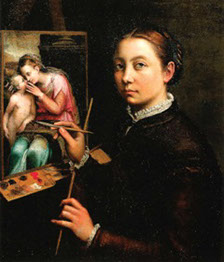
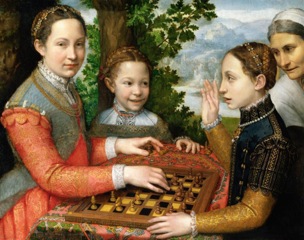

Sofonnisba Anguissola (1532-1625) Self portrait, Sisters Playing Chess, Family Portrait With Dog
The struggle for female equality and recognition in a world of male artists dates back to the 1500’s. Today, many extremely talented artists remain virtually unknown, such as Sofonnisba Anguissola, a Renaissance artist like Michelangeo and DaVinci. To be fair, like Sofonnisba, most of DaVinci’s students are not famous either. But art lovers are shocked to observe the skill of female painters hundreds of years ago when women were looked at only as mothers, wives, objects of beauty, cooks and seamstresses. Clearly, they also deserve homage as great artists.
Thanks to the National Museum of Women in the Arts and other pro-women art groups, slowly but surely progress has been made. Still, only 5% to 10% of the art in major museums is by women, and contemporary women artists still earn $20,000 less per year than men. Meanwhile, half of museum adminstrators are women, and 75% of the nude portraits in museums are of women. Centuries ago, and even in the early 20th century, women were not allowed to paint nude figures or study nude models.



Mary Blood Mellen (1819-1886) Field Beach
Niagara Falls by Louisa Davis Minot (1788-1858)
The "Hudson River School” was a 19th century American Art movement characterized by large, often monumental size landscapes of the Catskills, Adirondacks, Rocky Mountains, Niagara Falls and Grand Canyon. Male artists created most of these realistic and romantic depictions of the natural wonders of the United States, and that’s who you see in museums. Thomas Cole (1801-1848), Albert Bierstadt (1830-1902) and Frederick Church (1826-1900), are among the famous Hudson River School artists who captured the scenic beauty of America on their light-infused canvases. However, the men were not alone. Yet the appreciation of female Hudson River School artists was almost non-existent until the Smithsonian publicized a small Catskill, New York exhibition titled “Remember The Ladies: Women Of The Hudson River School” in 2010. Sadly, that exhibition was never followed up at the Smithsonian, the Metropolitan or any major art museum. Pennsylvania Through The Eyes Of Fern Coppedge will include a special chapter on the overlooked achievements of women artists including the Hudson River School, Impressionism and Modernism.
MODERN HEROES: CASSATT, O’KEEFE AND KAHLO
The lives and artwork of Mary Cassatt, Georgia O’Keefe and Frida Kahlo are well known. But they are among the minority who managed to break out of the feminine crowd. Thousands of important women artists, including Fern Coppedge, are still unknown and underappreciated, still “lost in the crowd.”
Born in Pennsylvania, Mary Cassatt (1844-1926) was an American expatriate who lived in France. Discouraged from pursuing an art career by her father, a wealthy stockbroker who refused to support her financially, she was estranged from him for decades. Just as Fern Coppedge was the only female member of the New Hope School, Mary Cassatt was one of only three female members of the Early French Impressionists. A close friend of her mentor Edgar Degas, Mary specialized in the human figure, at first painting views of society, like the opera, which evolved into her famous mother and child theme. Although Mary Cassatt was both a successful artist and an art advisor, she is the exception and not the rule. Had she decided to do as she was told by her family, would the world still be enthralled by her exceptional body of work?
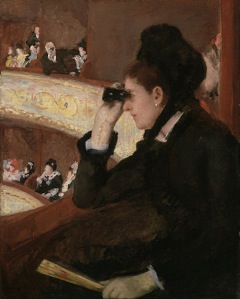


Mary Cassatt: In The Loge, The Boating Party, Young Mother Sewing
Georgia O’Keefe (1887-1986), the “Mother of American Modernism” and perhaps America’s most celebrated “woman painter" (sorry, Georgia), refused to attribute her success to her husband’s considerable influence. She was given her first solo exhibition by the famous art dealer / photographer Alfred Stieglitz in 1917, whom she married in 1924 and remained his wife until he died in 1946. A fiercely independent artist and human being, O’Keefe refused to paint flowers (one of her favorite subjects) the way people expected to see them. Like Fern Coppedge, she interepreted flowers to capture their essence and was wildly popular for her bold originality. Along with Mary Cassatt and Frida Kahlo, O’Keefe’s life will be revealed in greater detail in our Fern Coppedge book. Thankfully, Georgia O’Keefe is represented in all of the world’s highly visited museums.

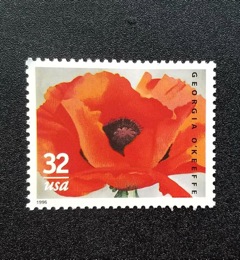

Georgia O’Keefe: Jimson Weed, U.S. Postage Stamp & Photo with her Husband Alfred Stieglitz
Frida Kahlo (1907-1954) is considered a Mexican artist. However, she lived in the United States from 1930-1933 during which time she created some of her most powerful paintings including the eye-catching Self-Portrait below in 1932. One of the world’s most controversial and highly political artists, Kahlo married Diego Rivera, Mexico’s honored and esteemed muralist who is considered a National Treasure in his country. Their marriage was as explosive as her paintings and her lifestyle. Throughout her short 47 years Frida Kahlo suffered, but not because of a lack of achievement in the world of art. Rather, her health was destroyed by a terrible vehicular accident at age 18 which ruined her life. Yet she persevered and used her art to gain attention for the many causes that motivated her. The life and art of Frida Kahlo is the antithesis of gender discrimination. Instead of struggling to get noticed as a woman artist, Frida Kahlo was both loved and hated for her outspoken feminine and radical ideas which included exposing gender bias in a shocking manner through her paintings. Like Georgia O’Keefe, it didn’t hurt that Kahlo’s husband was extremely well known. But would her talent have received the acclaim it truly deserved without the famous Diego Rivera in the picture?

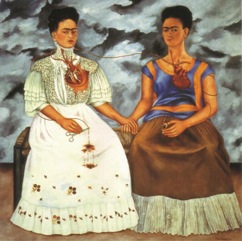

Frida Kahlo: Self-Portrait On Mexican-American Border, Me Twice, Photo of Mr. and Mrs. Diego Rivera
THE PHILADELPHIA TEN
In contrast to Mary Cassatt, Georgia O’Keefe and Frida Kahlo, members of the Philadelphia Ten led relatively normal lives and painted pretty pictures. Generally well-to-do women, these professional artists painted to be financially independent as well as for the sheer joy of creating art. They were truly happy to paint florals, landscapes, townscapes, harbor scenes and portraits that collectors acquired to brighten their homes and spirits. Fame was an afterthought.
M. Elizabeth Price (1877-1965), known for her decorative gold and silver laced floral panels and screens overflowing with peonies, poppies, irises, gladioli, hollyhocks and flowers from her own garden “Pumpkinseed Cottage”, came from an artistic family. One brother owned a New York City gallery, another crafted frames and married an artist, and her sister Alice married the New Hope impressionist Rae Sloan Bredin. Price exhibited regularly starting at the Corcoran in 1914 and ending with the final presentation of the Philadelphia Ten in 1945. From 1921 to 1934, she exhibited with the National Academy of Design 16 times, won the Carnegie Prize in 1927, and showed at the Pennsylvania Academy of Fine Arts for three decades. Many art galleries proudly offered her work for sale to delighted clients. Her illustrious career, built without a husband or children to attend to, earned her the praise of art critics and included landscapes and harbor scenes as well as florals. Being an artist allowed her to live a very good life filled with meaningful friendships and a view of the Delaware Canal from the windows of her home.
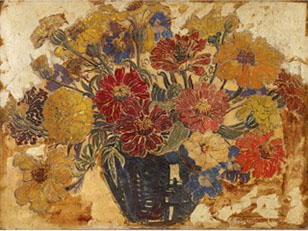


Vase With White Poppies (M. Elizabeth Price, left & below left), The Fruit Wagon, (Nancy Maybin Ferguson, center above and below), Saturday Morning, Upper West Side (Theresa Bernstein, right & below right)

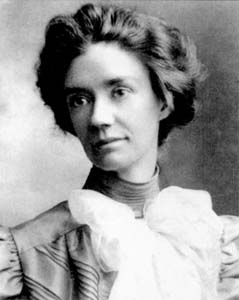
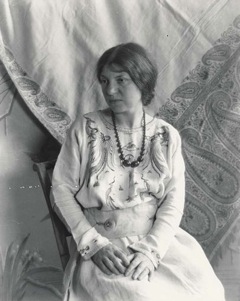
Nancy Maybin Ferguson (1872-1967) has a long list of art credentials and prizes including several Gold Medals. From age 19 to age 39 Ferguson attended art school at the Philadelphia School of Design and the Pennsylvania Academy of Fine Arts (PAFA). Her most popular subject matter was street scenes. These were compared to the heavily peopled, bright, colorful scenes created by Maurice Prendergast but still bring only a fraction of his value at auction. Nancy worked almost exclusively in Philadelphia and Provincetown both during and after her years with The Philadelphia Ten. She was quite successful during her long career and again, like most Philadelphia Ten artists, never married.
Within the Philadelphia Ten group the only true “art rebel" was Theresa Bernstein, the Ashcan style feminist whose gritty urban paintings stuck out like a sore thumb among the colorful gardens and pleasant winter scenes. Bernstein, who lived to be 111 years old (1890-2002) was married to the artist William Meyerowitz. She was one of the few married women in the group, but without children. From 1910 to 1930 she was plagued by gender barriers and the criticism that she "painted like a man”. Theresa Bernstein was a founding member of the Philadelphia Ten in 1917 and exhibited with the group until 1931. During those years newspapers proclaimed that the enthusiastic artist had invigorated The Ten with her outspoken and modernistic ideas. But Theresa decided that the Philadelphia Ten was not advancing her career and she resigned in 1931. Worth mentioning: Theresa Bernstein once advised Edward Hopper’s wife Josephine to keep her own last name as a woman artist in a man’s world. In 1968, “Jo” Nivision Hopper generously bequeathed her entire artistic estate and that of her husband to the Whitney Museum. Ironically, the Whitney has never shown her work, proving that being the wife of an art icon does not automatically bring fame despite the fact that Jo Hopper’s art once bested Georgia O’Keefe in a competition. By the same token, many people believe Edward Hopper's paintings were a collaboration of his wife’s talent as well as his own. Theresa Bernstein suffered no such problems. She was always her own woman and a strong proponent of women’s rights in the world of art.
Prominent Philadelphia Ten Artists
Eleanor Abrams (1885-1967)
Theresa Bernstein (1890-2002)
Cora Smalley Brooks (1885-1930)
Maude Drein Bryant (1880-1946)
Isabel Branson Cartright (1885-1966)
Mary-Russell Ferrell Colton (1889-1971)
Nancy Maybin Ferguson (1872-1967)
Edith Lucille Howard (1885-1960)
Susette Keast (1892-1932)
Emma Fordyce MacRae (1887-1974)
Helen Kiner McCarthy (1884-1927)
M. Elizabeth Price (1877-1965)
Susan Gertrude Schell (1891-1970)
Fern Coppedge (1883-1951)
Note: Pennsylvania Through The Eyes Of Fern Coppedge will feature an expanded “Women In Art” story that will include The Philadelphia Ten, The Plastic Club, The National Association of Women Artists, The Philadelphia School of Design For Women (Moore College), The National Museum of Women In The Arts, and other women’s art organizations.
Few creative artists, no matter how talented, find it easy to be financially successful in this esoteric profession. Throughout history, the trash can has exhibited thousands of times as many paintings as the museum. Regardless, the obstacles facing women artists have always been far more treacherous than those facing men. Gender discrimination is only one roadblock. How about balancing the career of an artist with the equally important career of a mother? Plus, learning, improving and convincing critics, dealers and the public of your greatness is perhaps even more difficult. In the modern age, Fern Coppedge and her renowned colleagues had a simple choice to make, first and foremost: Were they willing to pay any price to dedicate their lives to art? Was art truly their number one priority? If the answer was yes, the odds of achieving that worthy goal were definitely increased although never guaranteed.
THE MYSTERIOUS MARY CASSATT “MODERN WOMAN” MURAL OF 1893
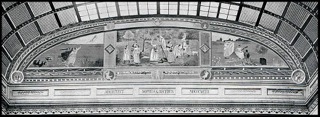
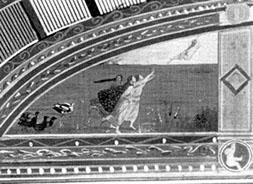
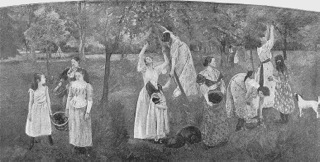
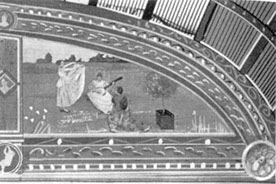
Modern Woman, a 52 foot mural created by Mary Cassatt for the Women’s Building of the 1893 Chicago World’s Fair or Columbian Exposition, has disappeared. The amazing story of this lost masterpiece will be told in our Fern Coppedge book.
Note: All images and text on this website may be reproduced online or in print at no charge provided that content is used for educational, scholarly and non-commercial purposes and with proper credit given. The “Fair Use” section of U.S. Copyright Law authorizes the reproduction of copyrighted materials (text and images) for such purposes with or without the permission of the copyright holder. The publisher of this website is authorized by the Kuns family (descendants of Fern Isabel Kuns Coppedge) to publish all images related to the artist. The Kuns family has also given permission to the James A. Michener Art Museum to publish images of Fern Coppedge paintings. Any other publication of images of Fern Coppedge paintings online or in print is not authorized by the Kuns family which retains exclusive rights to all images of Fern Coppedge paintings.
© Copyright 2022. Fern Coppedge photos, letters & stories to share? Contact us at: lesfoxnj@yahoo.com / AmericanArtAdvisor.com.